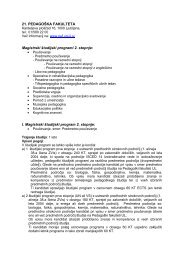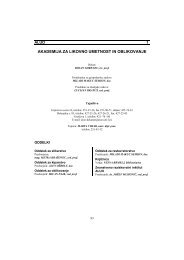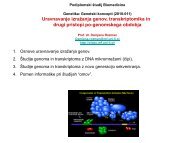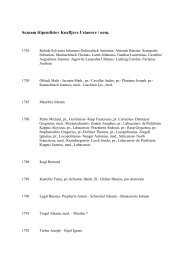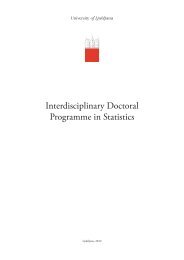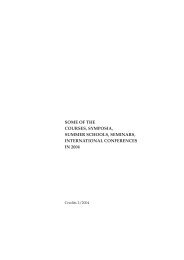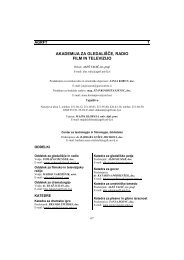Medicinska fakulteta Univerze v Ljubljani 1919–1945 - Univerza v ...
Medicinska fakulteta Univerze v Ljubljani 1919–1945 - Univerza v ...
Medicinska fakulteta Univerze v Ljubljani 1919–1945 - Univerza v ...
You also want an ePaper? Increase the reach of your titles
YUMPU automatically turns print PDFs into web optimized ePapers that Google loves.
logical Anatomy and an Institute of Experimental Pathology and<br />
Pharmacology; the sixth semester would require an internal clinic<br />
and a surgery clinic, the seventh semester a clinic of obstetrics<br />
and gynaecology and a clinic of psychiatry and neurology, the<br />
eight semester a clinic of ophthalmology and the ninth and tenth<br />
semesters a clinic of dermatology and venereology, a clinic of<br />
paediatrics, an institute of hygiene, and an Institute of Forensic<br />
Medicine, a clinic of tuberculogy, a clinic of laryngology and a<br />
clinic of dentistry� The alternative proposal to start with the first<br />
three semesters required building, converting and organising<br />
all the institutes and clinics a year sooner and the Institute of<br />
Histology and Physiology immediately�<br />
In early April, the Belgrade authorities temporarily put off<br />
solving the university issue, so University Commission President<br />
Dr Danilo Majaron intervened with the vice-president of the<br />
government, Dr Anton Korošec� Positive news from Belgrade<br />
came again at the end of May when the Ljubljana University was<br />
discussed in the Belgrade Parliament� In the beginning of June,<br />
the Ministry of Education submitted a draft act on establishing<br />
the Ljubljana University to the Council of Ministers which,<br />
however, objected to the establishment of the Faculty of Medicine<br />
and the decision on establishing the university was deferred as a<br />
result� On 26 June, Danilo Majaron went to Minister Davidovič<br />
in Belgrade, who was satisfied with his explanations regarding the<br />
Faculty of Medicine and submitted the draft act to the Council of<br />
Ministers where the bill on founding the University of Ljubljana<br />
was passed on 2 July� The bill provided for the establishment of<br />
a university in Ljubljana with five faculties including a medical<br />
faculty which comprised the first two preparatory years� The bill<br />
was passed in parliament on 16 July, signed by Regent Alexander<br />
on 23 July and published in the Official Gazette a month later�<br />
Faculty Arrangements and the First<br />
Academic Year<br />
On the last day of August 1919, Regent Alexander appointed the<br />
first professors of the University of Ljubljana nominated by the<br />
University Commission, among others Dr Albert Botteri, private<br />
assistant professor at the Faculty of Medicine, University of<br />
Prague, as full professor of ophthalmology, Dr Alfred Šerk, private<br />
assistant professor at the University of Prague, as full professor of<br />
neurology and psychiatry and Dr Janez Plečnik, the prosector at<br />
the Ljubljana Provincial Hospital, as associate professor of pathological<br />
anatomy� In late September, the University Commission<br />
was dissolved� The newly appointed professors convened on 18<br />
September as the University Council - the supreme university<br />
body which took over the University Commission’s affairs,<br />
continued with the work to open the university and took control<br />
of financial matters� On 12 November, the first university and<br />
120<br />
faculty officials were elected� The Faculty Council of the Faculty<br />
of Medicine elected its first dean, Dr Alfred Šerko, and its first<br />
vice-dean, Dr Albert Botteri� Under their guidance, the Faculty<br />
Council carried on with the preparations to arrange the faculty<br />
and start its activities�<br />
National freedom in the new state of Serbs, Croats and Slovenes<br />
brought Slovenes much of what we desired for a long time and also<br />
carefully prepared, but it also brought us much that we may have<br />
desired but did not prepare for adequately. When the University<br />
Commission started activities to realise the old Slovenian demand<br />
for a complete university, it found tilled soil for some sciences, but<br />
the soil was still unploughed for some sciences and faculties, wrote<br />
Alojz Zalokar on the university’s 20th anniversary and added that<br />
the sciences for which the ground was poorly or not at all prepared<br />
included first and foremost medicine� In organising the Faculty of<br />
Medicine, the Faculty Council thus faced greater problems than<br />
the other faculties of the Ljubljana University� The faculty had<br />
absolutely nothing to start work with; neither any premises, laboratories<br />
for practicals nor the necessary teaching aids� For a start, it<br />
was given just the Provincial Hospital’s Pathological Department�<br />
It was a small building with four ground-floor rooms, two autopsy<br />
rooms and a morgue� Work to rearrange the building into an<br />
anatomical institute started at once� Joining the autopsy rooms<br />
provided a small lecture hall which was sufficiently finished by<br />
early January to accommodate lectures in anatomy which had so<br />
far been held in the Provincial Mansion� The curriculum of the<br />
Ljubljana Faculty of Medicine was based on the curriculum of the<br />
faculty in Zagreb established in 1917� For only the first two years,<br />
the Ljubljana Faculty of Medicine was a kind of preparatory<br />
school teaching theoretical subjects and preparing its students<br />
for further study of clinical subjects� The first professors taught<br />
subjects from senior semesters, being appointed in the belief that<br />
the faculty would evolve soon, which led to a personnel complication<br />
solved by the Faculty by entrusting instruction in anatomy<br />
to Dr Janez Plečnik, otherwise the professor of pathological<br />
anatomy, whereas the neuropsychiatrist Dr Alfred Šerko gave<br />
lectures in anatomy and later also in nervous system physiology�<br />
Professor Plečnik, who was already appointed full professor of<br />
anatomy in January 1920, and Professor Šerko lectured in these<br />
temporarily assigned subjects until their death� The ophthalmologist<br />
Dr Albert Botteri took up first-year instruction in ocular<br />
anatomy and histology but as soon as the next year left for Zagreb<br />
as head of its ophthalmological clinic� In the time between the<br />
two world wars, chemistry classes were held at the Faculty of<br />
Technical Sciences or in the basement of the “Realka” secondary<br />
school, where Professor Maks Samec organised a chemistry<br />
laboratory� After mid-January 1920, medical students were<br />
taught biology five hours a week by the gymnasium professor Dr<br />
Pavel Grošelj as a part-time teacher at the Assembly Hall of the<br />
Provincial Mansion and experimental physics six hours a week by



